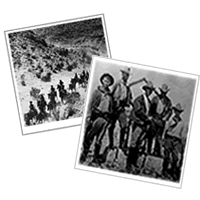Texas Border Violence 1910-1920
The Mexican Revolution had a profound effect on Texas during the early twentieth century and much of it was documented through photographs.
- Slide Show:

The lesson uses El Paso Public Library's photograph collections along with selected images from the Cattle Raisers Museum to provide first-hand accounts of a violent and disruptive period along the border between Mexico and the United States. First, however, this introduction will briefly examine the convoluted beginnings of the Mexican Revolution.
- Student Worksheet:
Worksheet questions stem from a variety of learning styles so that each student has the opportunity to shine. Teachers may also modify and easily incorporate these worksheets into their predesigned lesson plans.
- Web Links:
The web links provided will help each instructor prepare, research, and present interesting reputable sites during lectures.
Texas Border Violence 1910-1920
by Vale Fitzpatrick
Officially the Mexican Revolution began in 1910, when President Porfirio Díaz could no longer suppress opposition to his thirty-four year rule. Dissent had been building among various social, political, and power groups for years. Initially these opposition forces were united in their desire to see Díaz removed from power as a result of a corrupt presidential election. By 1911 with former presidential candidate Francisco I. Madero serving both as leader and unifying cause for the various opposition groups, led by Francisco Pancho Villa, Pascual Orozco, and Emiliano Zapata, the Díaz regime was deposed. On 24 May 1911 an exiled Díaz sailed for Paris, where he would die in 1915. In the following national elections Francisco I. Madero was honestly elected President of Mexico.
However, unity quickly faded as each faction began maneuvering to secure power. Sadly this is an all too common occurrence in Mexican politics. Historian Laurans Ballard Perry notes that: “Three elements of [classical] liberalism were desperately needed—democratic social values, guaranteed civil rights, and popular participation in strong local government. But no Mexican traditions supported them.”
Even before Madero’s inauguration there was a rising opposition to his government. Zapata whose demands for immediate land reform were not met and he broke with Madero, forming his own leftist revolutionary movement. The situation only deteriorated from that point for Madero. In March 1912 Pascual Orozco, angry at not being awarded governorship of Chihuahua, rebelled and allied with the counterrevolutionary White Guard (large land owners.) To put down this revolt President Madero turned to General Victoriano Huerta, a capable general, but sadly a man lacking in loyalty. Huerta wanted power and conspired with Felix Díaz, nephew to the exiled dictator, to seize power from Madero. In this he was urged on by his friend and fellow hard drinker U.S. Ambassador Henry Lane Wilson. In February 1913, Huerta staged his military coup shooting both Madero and his vice-president José Pino Suarez. His rule was promptly challenged by Zapata, a returned Villa, Mexican Senator Venustiano Carranza, and former senator Alvaro Obregón.
As the previous paragraphs illustrate the Mexican revolution is a complex topic, which becomes even more complicated after this point, to fully detail them is beyond the scope of this introduction.
So what did all the bloodshed and conflict of the Mexican Revolution mean for Texas? It meant that much of the violence and societal disruption occurring in Mexico filtered across the border into Texas. The United States-Mexico Border is 1,969 miles long and easily crossed by refugees, revolutionaries, and criminals. In response to the constant cross border crime and raids the Texas state government stationed its Texas Rangers along the border. However, there were simply not enough Texas Rangers to effectively police the border, Therefore the state legislature created “Special” Ranger companies, units which would have a decidedly mixed character. These “Special” Ranger companies lacked the training, command structure, and in many cases enlisted men of dubious character, further many “Special” ranger units suffered from poor discipline. With several companies no better than vigilantes, one entire company would be dismissed because of actions unbefitting the Ranger force. In 1919 the Texas States Legislature would initiate an official investigation of the Ranger force because these actions.
Eventually the governor would activate State National Guard units to patrol the border. Further the level of U.S. Army presence along the border was steadily increased throughout the decade. After the 6 January 1915 Plan de San Diego caused a minor race war in South Texas and Pancho Villa’s cross border attacks nearly the entire U.S. Army, heavily reinforced by National Guard Units, was stationed along the United States-Mexico border. It is estimated that by July 1916 the total troop commitment was 116,957 men. At several points war between the two nations seemed possible.
Throughout the decade of 1910-1920 large numbers of Mexican refugees also fled into Texas and other border states, to escape the violence ravaging their homeland, estimates range from 300,000 to one million. The exact number is impossible to know. Many, perhaps most, Mexican refugees lost most of their property and positions because of the revolution and were forced to start anew in the United States.
The uncertainly and lawlessness of the Mexican Revolution created an environment of fear and distrust along the Texas-Mexico Border, which was exacerbated by racial tensions. Economically the revolution disrupted cross border trade and markets as the violence and uncertainly stifled invests and cross border investment and business development.
Thus the Mexican Revolution touched every aspect of the Texan civil society, by removing the citizen’s sense of security, disrupting the economic life of many citizens, the state absorbed of large numbers of refugees into its communities, and outright violence cost many Texans and Mexicans their lives.
